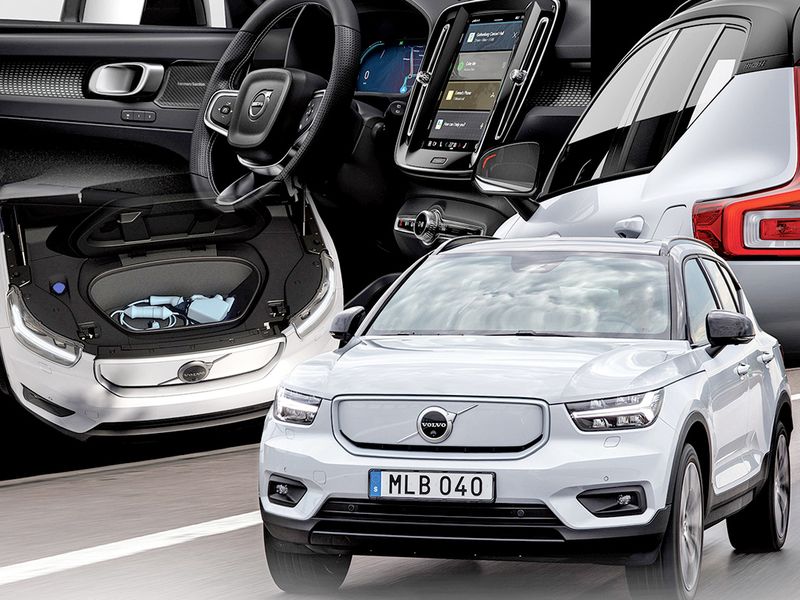
Volvo Car USA’s newest crossover signals the next chapter of the Swedish automaker’s evolution.
The 2021 Volvo XC40 Recharge P8, arriving in U.S. stores early next year, is the awkwardly named vanguard of a portfolio of emissions-free models.
“Electrification by far is the highest priority in the company,” Volvo Car USA CEO Anders Gustafsson told Automotive News last week.
Volvo’s bet on electrification is bold: Make battery-powered vehicles account for half of its global sales by 2025, with the rest being hybrids. To get there, Volvo is adopting a two-step strategy: Push plug-in hybrids in the near term as the EV lineup — and customer adoption — evolves.
“We have decided to go in very strong with our PHEVs,” Gustafsson said, noting Volvo commands a 23 percent share of plug-in hybrid sales in the U.S. luxury segment.
Volvo discontinued California sales of its T6 twin-turbocharged four-cylinder engine for the XC90 large crossover. Volvo now offers only the T5 turbocharged four-cylinder and T8 plug-in hybrid variants for the model. A spokesman would not say whether Volvo plans to drop the T6 variant across its range of sedans, wagons and crossovers.
Stringent limits on greenhouse gas emissions from vehicles in Europe and China are driving the auto industry to deploy more electrified powertrains to be able to continue selling vehicles.
“Any automaker that doesn’t move aggressively to launch vehicles with at least some zero-emissions capability will simply not be competitive, at least in Europe and China,” Guidehouse Insights analyst Sam Abuelsamid noted.
But the world’s second-largest auto market remains skeptical of the new technology. In the first nine months, EVs accounted for just 1.6 percent of U.S. vehicle sales, according to Kelley Blue Book.
As Volvo rolls out its EVs, the focus will be on profitability over market share.
“I don’t want to have price pressure,” Gustafsson said. “I don’t want to have the cars parked outside of any dealers.”
The XC40 Recharge has received the strongest pre-launch interest from customers in a new-vehicle introduction since the second-generation XC90 launched in 2015, Volvo told U.S. retailers last week. The company declined to disclose the number of preorders.
“The XC40 [Recharge] is the perfect electrified car for the U.S. market,” Gustafsson said. “We will compete directly with Tesla in a price range that’s going to be competitive.”
The 2021 XC40 Recharge P8 starts at $54,985, including shipping. Tax incentives for EV buyers would lower the price by at least $7,500. While the Tesla Model Y starts at $51,190, including destination, it does not qualify for the credit.
Beating the Model Y on price before other European luxury competitors would be key to Volvo’s potential success in that segment, said Sam Fiorani, vice president of AutoForecast Solutions.
“The XC40 is an outstanding small crossover in its own right, and adding the power and driveability of an electric drivetrain at a modest price should find a market,” Fiorani said.
But in another crucial metric, Volvo gets lapped. The XC40 EV’s range of 208 miles trails the competition. The Model Y leads the pack with 326 miles, followed by the Jaguar I-Pace at 234 miles and the Audi E-tron Sportback at 222 miles.
If Volvo executives have range anxiety, Gustafsson isn’t showing it. “Based on how our customers can charge the car, I think [range] is not going to be a concern,” he said.
Volvo is betting the new model will help sustain a robust recovery from the coronavirus shutdowns this year.
The brand’s U.S. sales have picked up faster than those of its European competitors and the overall industry. In the first nine months, Volvo sales are down 5 percent year over year compared with BMW’s 24 percent slump, Audi’s 22 percent slide and Mercedes-Benz’s 12 percent decline. In the latest quarter, Volvo outsold Ford Motor Co.’s luxury Lincoln brand by nearly 2,800 vehicles. Ford owned Volvo from 1999 to 2010.
Volvo’s sales rebounded from the COVID-19 slump in June and has seen year-over-year gains in every month since.
“We decided early to be very aggressive in the southern part of the country,” Gustafsson said. “So the first two or three months, the region was really the locomotive of the company.”
Volvo quickly implemented new operating procedures to help its dealers sell vehicles safely, including digital retailing, no-contact vehicle pickup and delivery, wearing masks and facility cleaning.
In March, the automaker introduced Volvo Valet, a mobile app that allows consumers to schedule pickup and delivery of vehicles for service or maintenance. The services are offered by 208 of Volvo’s 282 U.S. dealers.
Volvo also acted early to secure supply — nearly 90 percent of Volvos sold in the U.S. are built in Europe. The automaker prioritized production for the American market before the annual European summer shutdown.
“We were convinced that the U.S. was going to see a V-shaped recovery in terms of vehicle demand,” Gustafsson said.
Gustafsson is optimistic the retail momentum will continue.
“We are seeing good interest on our website, we see positive developments on floor traffic,” he said. “The vessels are full of cars — and exactly the cars that the dealers are asking for.”